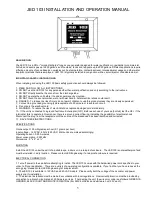
The Board
4
SLAA040
This feature fits well into monitoring application. For example, the ADC may have
to trigger on one event out of some channels inside an extremely small time
window and then sample the correct channel with a higher resolution, but lower
throughput to analyze this process. This feature also fits well into home security
applications or applications that must monitor several inputs simultaneously.
2.3.3
Note on the Interface, Using an External ADC Clock Drive
The TLV1562data sheet (Figure 9) shows that RD has to fall as close as possible
to the falling edge of the clock signal. The user must adhere to this timing,
otherwise the conversion result may be wrong. The user may not recognize the
erroneous result, since the ADC will signal that the conversion has finished during
the logic low transition of the INT signal. The following timing diagram shows the
interface behavior of the ADC whether the timing is correct or not. The following
figure shows what happens when the RD falling edge is timed wrong. Although
RD falls nearly 1/2 of one cycle too late, the conversion result is valid on the 5
th
clock cycle.
1
2
3
4
5
6
7
8
9
10
CLK
1
RD
INT
Conversion Starts
Next Sampling Starts
Conversion Finished
2.4
Onboard Components
These sections describe the EVM onboard components.
2.4.1
TLC5618A – Serial DAC
This 12-bit DAC has a serial interface that can run at 20-MHz clock; therefore, it
can update the output at 1.21 MSPS. Two outputs are available on the 8-pin
package. The buffered SPI of the DSP provides the DSP interface. Using the
auto-buffer mode, updating the data on the DAC requires only four CPU
instructions/samples.
Summary of Contents for TLV1562
Page 6: ...vi SLAA040 ...











































